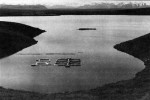The site is located at 69°N near Toolik Lake, an oligotrophic kettle lake in the northern foothills of the Brooks Range, Alaska. Nearby are found all of the common types of arctic tundra as well as a number of lakes and streams of various sizes. The entire region is underlain by permafrost, with continuous daylight from mid May to late July and a snow-free season normally lasting from late May to late September. The research camp at Toolik Lake is operated by the University of Alaska, has a capacity of 40 scientists, and is accessible year-round by gravel road from either Prudhoe Bay (4 hours) or Fairbanks (9 hours). The road, which parallels the oil pipeline, provides access to boreal forests, river valleys, mountain valleys, and the arctic coastal plain.
Long term aquatic research at Toolik Lake began in 1975 and terrestrial ecologists began long term experiments and observations there in 1976. Since then, about 25-30 senior investigators and many more students and technicians in the United States and Europe, have worked at Toolik Lake. About 10 of these scientists have maintained their research there continuously since the mid-1970s.
The new arctic LTER program at Toolik Lake is designed to build on this extensive research base, to provide core funding for ongoing, long-term experiments, and to link terrestrial, lake, and stream studies more explicitly than has been possible hi the pest. The program currently includes 15 principal investigators from 7 different institutions, including the Universities of Alaska, Cincinnati, Kansas, Massachusetts, and Minnesota, Clarkson Technology Institute, and the lead institution, the Marine Biological Laboratory, Woods Hole, Massachusetts.
The heart of the program is a series of parallel, whole-ecosystem experiments in lakes, streams, and the major terrestrial ecosystem types. The experiments are of two kinds: “top-down” manipulations of herbivores or predators, and “bottom-up” manipulations of nutrient availability. The overall goal is to understand and to separate the role of animal consumers versus plant nutrient responses as controls over terrestrial and aquatic ecosystems.
Previous research at Toolik Lake has shown that arctic ecosystems respond dramatically to such experimental manipulations, and that the responses are often easier to interpret than in more complex, species-rich ecosystems at lower latitudes. The effects of manipulation can often be traced clearly through several trophic levels; in addition there are major changes in productivity and species composition within trophic levels or guilds. For example, phosphorus fertilization of the Kuparuk River (near Toolik Lake) changed the entire basis of the food web from heterotrophy to autotrophy by stimulating algal growth, it changed the structure of the insect community by favoring grazers over particle collectors, and it sharply increased growth of larval and adult fish. Fertilization experiments in a lake have resulted in changes in both zooplankton and benthic community structure and provided an excellent example of predator-prey dynamics within the microbial food web. On land the growth form composition of the vegetation as well as its productivity is strongly affected by nutrient availability as well as by air temperature and shading. An important reason for continuing these experiments in the long term is that not all species respond at the same rate, and that there is much to be learned by observing the sequence of changes and interpreting their causes.
A second major goal of the arctic LTER program is to advance understanding of how mineral nutrients move over the arctic landscape, from terrestrial to aquatic ecosystems. This goal is especially important in the context of human disturbance because we know that the structure and productivity of terrestrial ecosystems is strongly nutrient-limited, and that disturbance in general tends to increase nutrient cycling rates arid overall nutrient availability. We also know that aquatic ecosystems are strongly dependent on nutrient inputs from the surrounding tundra. To describe the cycling of nutrients within different terrestrial ecosystems, and the movement of nutrients over the landscape, we are focusing on development of a model of nutrient transport, combined with the use of stable isotopes as tracers to identify major sources, sinks, and pathways of element cycling.
For additional information contact John E. Hobbie, The Ecosystems Center, Marine Biological Laboratory, Woods Hole, MA 02543.

 Enlarge this image
Enlarge this image